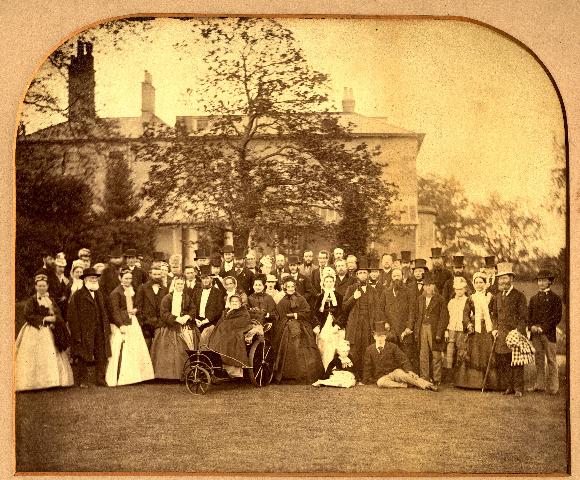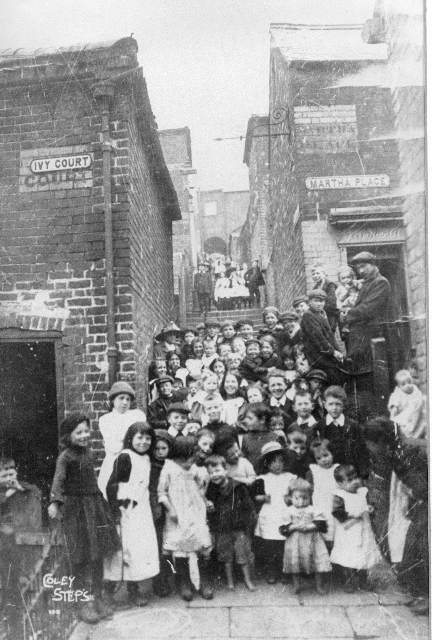Urban growth
Huntley & Palmers began their spectacular period of growth at the same time as the railway arrived. Other businesses, too, began to flourish in this period - we will look at them a little later.
The rapid growth of the town can be most easily shown by looking a series of maps produced in the course of the century. In a short period of time what had been open green fields was covered with suburbs. Cemetery Junction, for example, which had been a crossroads surrounded by fields when the station was built was, by 1900, surrounded by terrace housing.
A tide of red bricks
Reading changed from being a market town to a smoky industrial town. Many regretted the change. Thomas Hardy refers to the town as 'Aldbrickham' in his novel Jude the Obscure - clearly the town was associated in his mind with a tide of red bricks sweeping across the countryside.
Social Contrasts
The growth of the town was so rapid that it created an unplanned mix of rich and poor housing. Typical of this was the situation along the King's Road. This road had been built in 1834 on land that had belonged to the Crown - and before that it had belonged to Reading Abbey. It was thought that this area would be suitable for large villas and many were built faced with expensive Bath stone. Several such houses still stand along the road.
On the site of what is now Reading College there was a formal square of large houses with extensive gardens to the rear, with stables. This elegant housing development was known as Victoria Square. With the siting of the Huntley & Palmers factory nearby in 1846 these houses were to find themselves uncomfortably close to an industrial area. Moreover, the new factory demanded an ever increasing supply of factory workers. Their housing needed to be close to the factory, so that they could walk there and back. Newtown, an area of dense terrace housing pressed up against the rear of Victoria Square.

Three generations of the Palmer family with some of their key factory employees. The photo was taken in 1870 at the family's garden party at The Acacias, the Palmers' Reading home. (REDMG : 1997.130.569)
The Palmers and the Windsors
The 1881 census shows that Alfred Palmer lived in 11 Victoria Square. Alfred was the second son of George Palmer. At the time of census he was 28, married and had two twin children - Phyllis and Eustace. He was in charge of the steam engines in the factory - in fact, he named several engines after the women in his family. One was called Alice, another Phyllis and later one was named after his granddaughter Betty. At the time of the census Alfred had four female domestic servants in his house.
By way of contrast, just across the road from his house, was an area packed with small terrace houses. The same census tells us that in one of these streets (4 Eldon Street) there lived 42 year old Cornelius Windsor and his wife Eliza. Cornelius worked in the Huntley & Palmers factory and had come to Reading from Pewsey in Wiltshire. His wife, also, had been born a country girl - from Windford, Somerset. They had seven children - Eliza Jane, Ernest, Walter, Herbert, Edith, Daisy and Lilly, whose ages ranged from one to thirteen. Unlike the Palmers on the other side of the road they had no domestic servants! Their small two bed roomed house is still standing, although the large detached house of the Palmers was demolished after the Second World War. All that is left of Victoria Square is a mature Cedar of Lebanon in the grounds of Reading College.
Reading's unique brickwork
Thomas Hardy may have deplored the spread of red brick across Reading, but it is now recognized Reading's Victorian suburbs contain some outstanding examples of nineteenth century brickwork. Detached houses for the middle class all were decorated with elaborately moulded terracotta features and patterns using red, cream and grey bricks. Light grey bricks, in particular, became a distinctive feature of buildings in Reading and the surrounding area. The Town Hall, which was built in three stages between 1875 and 1894, and which also contains Reading Museum, features attractive brickwork of this kind.

Coley Steps, about 1911. During the nineteenth century slum housing at Coley Steps was the most impoverished area of Reading. The Steps ran down the slope towards the River Kennet between Coley Place and Wolseley Street (REDMG : 1999.1.1)
Living conditions for workers
Although Reading became an industrial town the standard of housing for workers was, in contrast to workers in industrial region of the north, relatively high. Many of the houses in Newtown, which was close to the factory and home to hundreds of workers, feature fancy brickwork patterns, have bay windows at the front and gardens at the rear. However, there were also areas of Reading with miserable slum housing, including Coley Steps and Hosier Street, that were cleared in the 1930s.
By the 1900s Huntley & Palmers employed up to 25% of Reading’s working population,and although fondly remembered by many as a paternalistic employer this was found to be having a real impact people’s lives. A 1912 survey by University College Reading (the forerunner of the University of Reading) found that 20% of all Reading families were living in poverty below the level needed to maintain physical health by the standards of the day.
Now, although we referred to the three Bs in the previous page, what if we told you that actually there are more than just the three? Read on to learn about our town's links with beer, bulbs and bricks.





